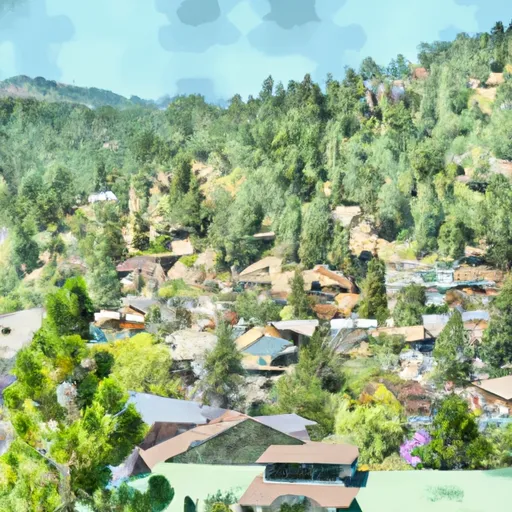-
 Snoflo Premium
Snoflo Premium
Get unlimited access to all our content
With no Ad interruptions! - Start Your Free Trial Login with existing account
Kyburz
Eden Index
Climate
9.3
•
Recreation
8.2
•
Community
1.3
•
Safeguard
6.9/10

Kyburz, California is a small unincorporated community located in El Dorado County, nestled in the Sierra Nevada Mountains. The climate in Kyburz experiences mild summers and cold winters, with average temperatures ranging from the mid-30s°F to the upper 70s°F. It is characterized by an alpine climate, with occasional snowfall during the winter months.
Kyburz is surrounded by pristine natural landscapes, offering several outdoor recreation opportunities. It is located along the South Fork of the American River, making it an ideal destination for water-based activities like fishing, kayaking, and rafting. The area is also renowned for its hiking trails, including the popular Pacific Crest Trail and the scenic Lover's Leap trail, which offers breathtaking views of the surrounding mountains.
In terms of hydrology constituents, the community of Kyburz is influenced by the South Fork of the American River, which provides a source of water for various recreational activities. The river is known for its clear waters and abundance of fish species, attracting anglers from near and far.
Overall, Kyburz offers an inviting climate, beautiful natural surroundings, and exciting outdoor recreation opportunities, making it a desirable destination for nature lovers and outdoor enthusiasts.
What is the Eden Index?
The Snoflo Eden Index serves as a comprehensive rating system for regions, evaluating their desirability through a holistic assessment of climate health, outdoor recreation opportunities, and natural disaster risk, acknowledging the profound impact of these factors on livability and well-being.
Climate Health Indicator (CHI): 9.3
Kyburz receives approximately
1289mm of rain per year,
with humidity levels near 75%
and air temperatures averaging around
11°C.
Kyburz has a plant hardyness factor of
8, meaning
plants and agriculture in this region tend to thrive here all year round.
By considering the ideal temperature range, reliable water supplies, clean air, and stable seasonal rain or snowpacks, the Climate Health Indicator (CHI) underscores the significance of a healthy climate as the foundation for quality living.
A healthy climate is paramount for ensuring a high quality of life and livability in a region, fostering both physical well-being and environmental harmony. This can be characterized by ideal temperatures, reliable access to water supplies, clean air, and consistent seasonal rain or snowpacks.
Weather Forecast
Streamflow Conditions
Lower Sacramento
Area Rivers
Lower Sacramento
Snowpack Depths
Lower Sacramento
Reservoir Storage Capacity
Lower Sacramento
Groundwater Levels
Recreational Opportunity Index (ROI): 8.2
The Recreational Opportunity Index (ROI) recognizes the value of outdoor recreational options, such as parks, hiking trails, camping sites, and fishing spots, while acknowledging that climate plays a pivotal role in ensuring the comfort and consistency of these experiences.
Access to outdoor recreational opportunities, encompassing activities such as parks, hiking, camping, and fishing, is crucial for overall well-being, and the climate plays a pivotal role in enabling and enhancing these experiences, ensuring that individuals can engage in nature-based activities comfortably and consistently.
Camping Areas
| Campground | Campsites | Reservations | Toilets | Showers | Elevation |
|---|---|---|---|---|---|
| Pleasant Dispersed | 10 | 6,413 ft | |||
| Airport Flat | 16 | 5,383 ft | |||
| Wentworth Springs | 8 | 6,153 ft | |||
| D.L. Bliss State Park | 170 | 6,872 ft | |||
| Gerle Creek | 50 | 5,272 ft | |||
| Meeks Bay | 40 | 6,225 ft | |||
| Sugar Pine Point State Park | 175 | 6,465 ft | |||
| Hell Hole | 10 | 5,167 ft | |||
| Northshore | 15 | 6,411 ft | |||
| William Kent | 95 | 6,337 ft |
Nearby Ski Areas
Catastrophe Safeguard Index (CSI):
The Catastrophe Safeguard Index (CSI) recognizes that natural disaster risk, encompassing floods, fires, hurricanes, and tornadoes, can drastically affect safety and the overall appeal of an area.
The level of natural disaster risk in a region significantly affects safety and the overall livability, with climate change amplifying these risks by potentially increasing the frequency and intensity of events like floods, fires, hurricanes, and tornadoes, thereby posing substantial challenges to community resilience and well-being.
Community Resilience Indicator (CRI): 1.3
The Community Resilience Indicator (CRI) recognizes that education, healthcare, and socioeconomics are crucial to the well-being of a region. The CRI acknowledges the profound impact of these elements on residents' overall quality of life. By evaluating educational resources, healthcare accessibility, and economic inclusivity, the index captures the essential aspects that contribute to a thriving community, fostering resident satisfaction, equity, and social cohesion.

